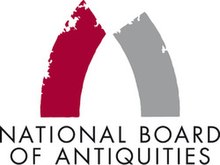
Helsinki is the capital and most populous city in Finland. It is located on the shore of the Gulf of Finland and serves as the seat of the Uusimaa region in southern Finland. Approximately 0.67 million people live in the municipality, with 1.25 million in the capital region, and 1.58 million in the metropolitan area. As the most populous urban area in Finland, it is the country's most significant centre for politics, education, finance, culture, and research. Helsinki is situated 80 kilometres (50 mi) to the north of Tallinn, Estonia, 360 kilometres (220 mi) to the north of Riga, Latvia, 400 kilometres (250 mi) to the east of Stockholm, Sweden, and 300 kilometres (190 mi) to the west of Saint Petersburg, Russia. Helsinki has significant historical connections with these four cities.

The Finnish sauna is a substantial part of Finnish and Estonian culture.

Finland attracted over 6.8 million foreign tourists in 2018, with 53 percent coming from other European Union states. In 2017, the value added by tourism was about 4.6 billion euros, or 2.6% of the Finnish GDP, providing approximately 140,200 jobs.
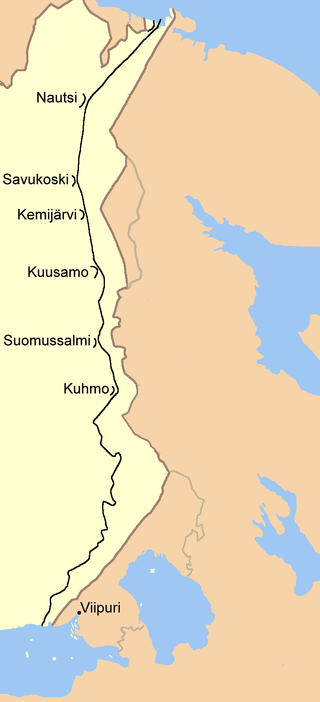
The Salpa Line, or its official name, Suomen Salpa, is a bunker line on the eastern border of Finland. It was built in 1940–1941 during the Interim Peace between the Winter War and the Continuation War and further in 1944 to defend Finland against a possible Soviet invasion.

Raisio is a town in Finland, located in the Southwest Finland region. It lies north of the regional capital, Turku. The population of Raisio is approximately 25,000, while the sub-region has a population of approximately 347,000. It is the 40th most populous municipality in Finland, and the third largest municipality in the Southwest Finland region after Turku ja Kaarina.
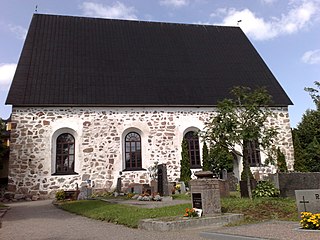
Siuntio is a municipality in the Uusimaa region of Southern Finland. Its neighboring municipalities are Ingå to the west, Kirkkonummi, to the east, Lohja to the north-west, and Vihti to the north. It is 46 kilometres (29 mi) west of Helsinki.

Ekenäs is a town and former municipality in Finland that comprised the former municipalities of Snappertuna and Tenala together with the town of Ekenäs. It was merged with Pohja and Karis to form the new municipality of Raseborg on January 1, 2009. Ekenäs is in the province of Southern Finland, and is part of the Uusimaa region. The town had a population of 14,754 and covered a land area of 726.73 square kilometres (280.59 sq mi). The population density was 20.30 inhabitants per square kilometre (52.6/sq mi). The town is bilingual, with the majority being Swedish speakers (81%), and the minority Finnish speakers (17%).
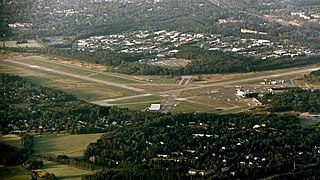
Helsinki-Malmi Airport(IATA: HEM, ICAO: EFHF) was an airfield in Helsinki, Finland, located in the district of Malmi, 5.4 NM north-north-east of the city centre. It was opened in 1936. Until the opening of Helsinki-Vantaa Airport in 1952, it was the main airport of Helsinki and of Finland. After that, it was used for general aviation and flight training, and remained the second-busiest airport in Finland, as measured by the number of landings, after Helsinki-Vantaa Airport. The city of Helsinki, which owns the land the airport is located on, terminated its lease agreement for aviation purposes in December 2019, and its remaining runway was closed in March 2021, but several legal complaints are pending in courts. The city plans to use the land for the construction of approximately 25,000 new apartments starting in 2024. The airfield area, including the runways and taxiways, was opened for public recreation in February 2022.

The National Nordic Museum is a museum in the Ballard neighborhood of Seattle, Washington, United States, dedicated to the Nordic history, art, culture, and the heritage of the area's Nordic immigrants. It was founded in 1980 as the Nordic Heritage Museum, moved into a permanent, purpose-built facility in 2018 named the Nordic Museum, and was designated as the National Nordic Museum in 2019. The museum serves as a community gathering place and shares Nordic culture by exhibiting art and objects, preserving collections, and providing educational and cultural experiences from Danish, Finnish, Icelandic, Norwegian and Swedish Americans. The geographical region covered by the Museum includes entire Nordic region.

Tavastia Castle or Häme Castle is a medieval castle in Tavastia Proper, Finland. It is located in Hämeenlinna, the city between Helsinki and Tampere. Originally located on an island, the castle now sits on the coast of lake Vanajavesi. The castle consists of a central keep and surrounding curtain walls, enclosed by a moat. The keep originally had five turrets, but only two are apparent today. The curtain wall has a gatehouse, battlements, an octagonal brick corner turret, and a round gun turret. The lower tiers of the keep and curtain wall are of masoned granite and the upper tiers are red brickwork.
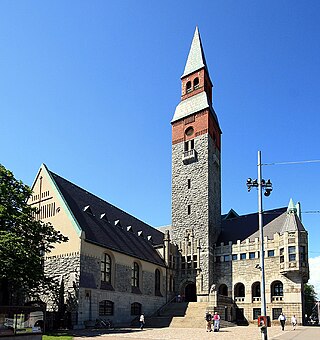
The National Museum of Finland is a museum in Helsinki presenting Finnish history from the Stone Age to the present day, through objects and cultural history. The Finnish National Romantic style building is located at Mannerheimintie 34 in central Helsinki and is a part of the Finnish Heritage Agency, under the Ministry of Culture and Education.

Kaustinen Folk Music Festival, celebrated yearly in July in Kaustinen, Finland, is the biggest folk music and dance festival in the Nordic countries. It was first celebrated in 1968. The festival originated in showcasing the famous local fiddle-based music tradition, which has continued uninterrupted 250 or more years, and is still the emotional core of the event. Finland has decided to propose the Kaustinen tradition into Unesco Representative List of Intangible Cultural Heritage spring 2020.

Vartiovuori Observatory is a former observatory in Turku, Finland. The observatory, designed by Carl Ludvig Engel, was originally built for the Royal Academy of Turku. The neoclassical building was completed in 1819. The observatory is situated atop the Vartiovuori hill, and it is clearly visible from different sides of the city centre.
The Salpa Line Museum was established and opened in 1987 by the municipality of Miehikkälä and by World War II veteran organisations. It is the first museum established in Miehikkälä. The other museums are the Miehikkälän kotiseutumuseo and the Miehikkälä local arts and crafts museum, which was established in 1989 and is located in the same building as the Engineers Museum.

Louhisaari Manor is a historic baroque manor house in Askainen in the municipality of Masku, Western Finland Province, Finland. The mansion is the birthplace and childhood home of Carl Gustaf Emil Mannerheim, Finnish military leader, statesman and sixth president of Finland (1944–1946).

The Church of Loimaa Proper is a church located in the municipality of Loimaa, Finland. It serves as the main church for the parish of Loimaa and is a visible landmark in the middle of countryside.

The Alajärvi administrative centre is a buildings complex in the city of Alajärvi, Finland, comprising the city hall and related offices, health centre, parish hall and other buildings. It was designed by Finnish architect Alvar Aalto, who also designed the adjacent library building.

Kytäjä is a village located in Hyvinkää, Finland. Kytäjä is along the connecting road 1361 about 15 kilometers west of the center of Hyvinkää and about 17 kilometers east of Loppi's Läyliäinen. Until 1917, the village belonged to the parish of Nurmijärvi and until 1968 to the rural municipality of Hyvinkää. Lake Kytäjärvi, which dominates the Kytäjä's landscape, flows down the Kytäjoki River into the Vantaa River.

Panelia is a village in the municipality of Eura in Satakunta, Finland. It is located on the connecting road 2172, about 15 kilometres (9.3 mi) away from the town centers of Eura and Harjavalta. Panelia has a population of 850 inhabitants, and, along with the Eurakoski village, it was the second urban area in the former municipality of Kiukainen, which joined Eura in 2009.
